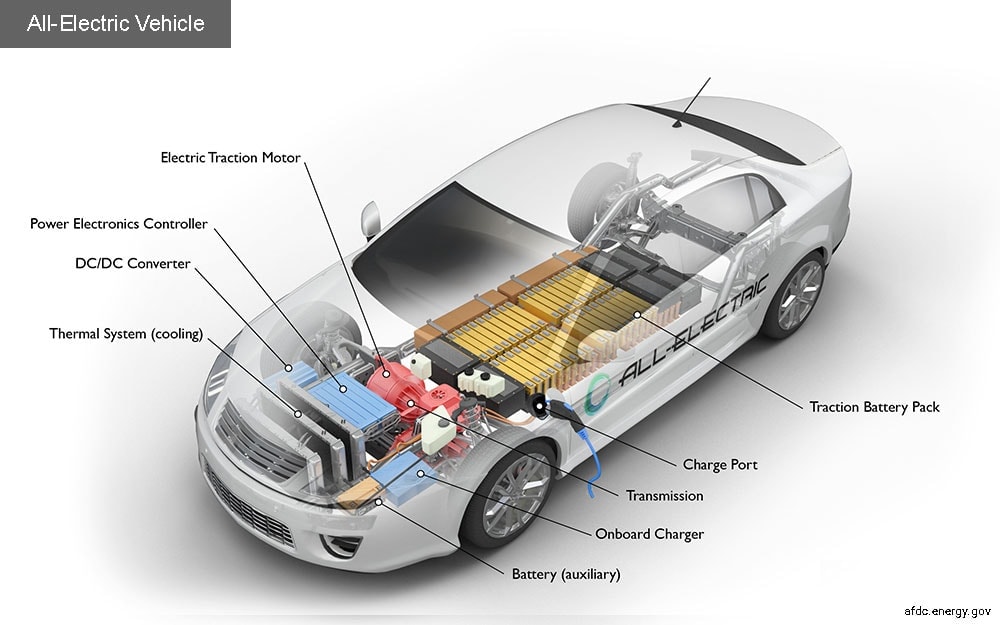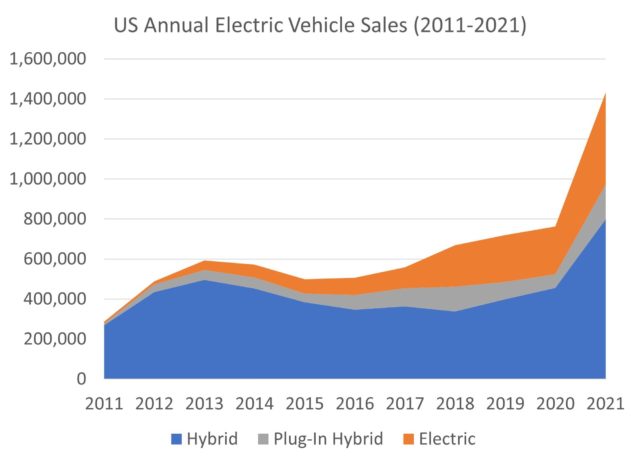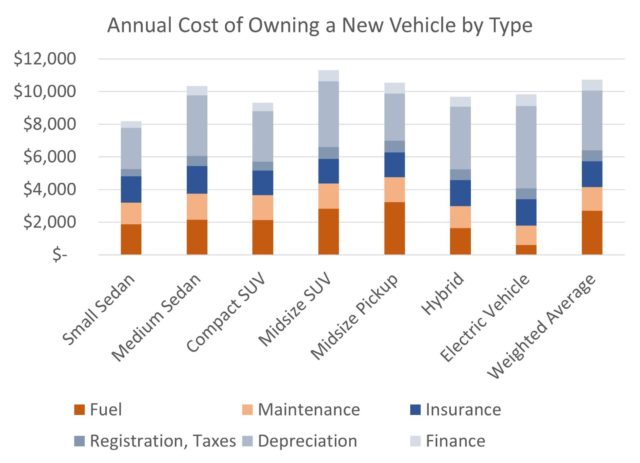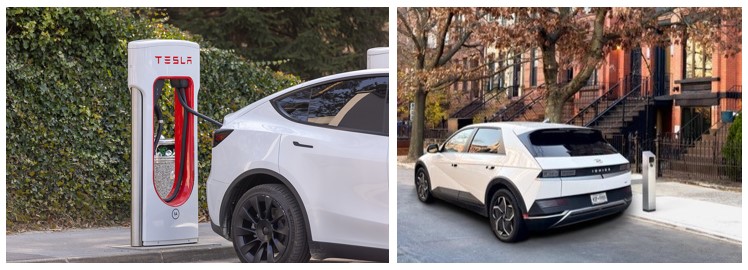January 24, 2023
The EV Revolution: Cost, Performance, Safety, and Environmental Impacts
By Michael Brower
It’s stunning to think how far electric vehicles, or EVs, have come in such a short time. EVs have been around for as long as their gasoline- and diesel-powered counterparts, but it’s only in the last 10-15 years or so that their cost and performance have improved sufficiently compared to conventional cars that they are becoming attractive for everyday driving needs. Today, hybrid- and all-electric cars have become a common sight on city streets and highways. In 2021, in fact, some 10% of all new cars and light-trucks sold in the United States had electric motors, about one-third of which were powered entirely by batteries; and the proportion is growing fast .
And yet, it must be said that EVs remain largely peripheral to the daily lives of most people, especially to those living in historically marginalized and economically challenged communities. They’re seen as expensive, for one thing, and some of the leading brands are unapologetically aimed at upscale markets. Furthermore, the ways they can benefit local economies, environmental quality, and public health are rarely recognized or discussed.
So, what do EVs really have to offer if you’re among the majority of Americans who would find it challenging to purchase a Tesla ? This blog, the first in a series on the topic of EVs and equity, begins to explore this question by looking at cost, safety, and environmental impacts.
Types of EVs. EVs come in many types, from trolley cars powered by overhead lines to subway trains drawing their energy from third rails. Here we are concerned with road vehicles, including cars, vans, trucks, and buses. All have the following three main electrical components (Fig. 1):
- an electric motor to drive the wheels
- a battery pack to store electricity and send power to the motor
- a charging system that connects to the grid and charges the battery
Hybrid EVs draw supplemental energy from on-board gasoline engines, making it unnecessary to find places to charge them (though many hybrid models now have plug-in options). But an increasing proportion of EVs sold today – around one-third in 2022 – are “pure” electric vehicles relying solely on their batteries to provide power.
All EVs have, in addition, sophisticated electronics to manage the power flow from battery to motor to wheels and the ability (with regenerative braking) to recover energy and send it back again to the battery; and they are equipped with familiar driver controls that make it easy for anyone who has driven an ordinary car, bus, or truck to manage their EV versions.

EVs in the Market. EV sales today are growing rapidly. In 2021, US sales of all-electric vehicles (excluding hybrids) nearly doubled over the previous calendar year, from 238,540 to 459,426, according to US government data.¹ Including hybrids, EV sales reached 1.4 million in 2021, 9.5% of all car and truck sales in the United States – up from 3.2% just 5 years earlier. The trend is almost certain to continue, and EVs will likely dominate the automotive market within a decade.2 The State of California, the country’s biggest car market, has announced that by 2035, all cars and trucks sold in the state will have to be zero emission vehicles (ZEVs), meaning mainly EVs.3 And other states are beginning to follow suit.4
Once popular mainly with environmental first adopters and technology enthusiasts, EVs are spreading to other consumers thanks to their declining cost and improving performance. According to a 2020 survey by Consumer Reports, around a third of American drivers would consider an electric vehicle for their next car or truck purchase.5 The Federal Government has set a goal that half of all vehicles sold in 2030 will be ZEVs, mainly EVs.
One of the leaders in this EV revolution has been Tesla, whose sleek and sporty cars have become a familiar sight on many US roads. But now nearly all auto makers have EV editions of their cars, trucks, buses, and other vehicles. The best-selling vehicle – truck or car – in the US, the Ford F-150, now comes in an EV version, the F-150 Lightning. Other popular examples include early pioneers such as the Nissan Leaf and relative latecomers such as the Hyundai Kona Electric, Kia EV6, and Rivian R1S SUV and R1T pickup truck. Even the iconic Ford Mustang comes in an EV version: the Mach-E, which was named one of Consumer Reports’ Top 10 cars of 2022.6

The Cost of Owning EVs. With their hefty battery packs, electric cars and other vehicles generally cost more upfront than their gasoline- and diesel-powered counterparts. At the same time, they cost less to drive – both in maintenance and in fuel costs. While the comparison depends on details such as financing costs and depreciation, the cost of fuel and electricity, and other factors, studies show that the total lifetime cost of owning gasoline-powered vehicles and EVs are similar. For example, in its 2022 Your Driving Costs study, the American Automobile Association (AAA) put electric vehicles in the second-lowest overall total cost category per mile driven, at 60.32 cents/mile, above small sedans (54.56 cents/mile) and below the average car (71.52 cents/mile), for vehicles driven 15,000 miles a year.7 This comparison includes tax credits that make EVs cheaper for some, but not all, buyers. Excluding tax credits puts the total EV ownership cost in the middle of the pack (Fig. 3).

Let’s start with the upfront cost. While it’s not always easy to make head-to-head comparisons, new electric cars typically cost about $10,000-$15,000 more to buy than their conventional equivalents. For example, according to Car and Driver, in October 2022, a “basic” Hyundai Kona Electric was priced $12,700 above the conventional Kona, whereas the Ford F-150 Lightning with XLT trim was $13,800 more than the same version of the F-150. On an industry average basis, the gap is larger, in part because EVs – like the Tesla – tend to be aimed at the luxury market. Kelly Blue Book reports that the average new EV sale price reached $65,290 in September 2022, $17,200 more than the industry-average new car.10
While the gap is substantial, tax credits and other incentives can help close it. Since 2010, the US Federal Government has offered a tax credit of up to $7,500 for buyers of new electric cars and trucks. This credit, which was due to expire in 2021, was extended another 10 years to 2032 with the passage of the 2022 Inflation Reduction Act (IRA). The IRA also introduced a one-time tax credit of up to $4,000 for buyers of used electric cars more than 2 years old, and it expanded the new-vehicle credits to include commercial vehicles for the first time.11
On top of the Federal tax credit, 31 states and the District of Columbia offer rebates or other incentives for owning an electric car or plug-in hybrid, according to the North Carolina Clean Energy Center.12 In Massachusetts, for example, electric car buyers can receive a $2,500 rebate on a new EV if the purchase price is less than $50,000.13 Combining both federal and state incentives, it may be possible to reduce the typical $10,000-$15,000 gap in up-front cost by one-half or more.
Unfortunately, the Federal EV tax credit – including the one for used cars – benefits only those buyers who pay enough in Federal taxes to be able to use them. Any unused credit cannot be refunded or carried over from one tax year to the next. This leaves many potential buyers – especially those of lower income – having to pay full price for EVs. There is discussion of changing this rule to allow credits to be applied at the point of sale, regardless of income tax owed, but no such change has been implemented yet. On the other hand, the IRA places limits on the maximum adjusted gross income for car buyers and on the purchase price of EVs to qualify for the tax credits, which are intended to encourage sales of less expensive vehicles to middle-income buyers.14
At the same time, EVs offer big savings in operating costs. The average cost of “fueling” electric cars is typically one-third that of gasoline and diesel cars, or less, depending on the type of EV and how and where it is recharged, the type of conventional car, and local prices of electricity and gasoline or diesel fuel. Because they have many fewer moving parts (such as pistons and transmissions) requiring lubricating fluids and prone to wearing out or failing, their maintenance costs are also lower than those of conventional cars. AAA estimates the average fueling cost of EVs at 4.04 cents/mile driven, compared to 12.51 cents/mile for the cheapest conventional category, small sedans. Combined with maintenance, the operating cost of EVs is 11.98 cents/mile, nearly 10 cents/mile less than small conventional sedans at 21.38 cents/mile. In a year of driving 15,000 miles, that amounts to an annual average savings of $1,410. Over 10 years, the savings can more than compensate for the additional up-front cost of EVs, especially if incentives such as tax credits are available.
Performance Characteristics. EVs have both positive and negative performance aspects, as well. On the plus side, they can achieve better acceleration than most gasoline- and diesel-powered cars, thanks to the high torque generated by electric motors. The Tesla Model S “Plaid” holds the world time record for 0-60 mph (1.98s), just beating out a number of luxury Ferraris, Porsches, Lamborghinis, and Bugatis.15 What’s more, because their motors work well over a wide range of RPM, they need no transmissions, making them simpler to operate and maintain and less prone to breakdowns.
On the other hand, EVs generally have a shorter driving range than their conventional counterparts. The median range for EV cars on a single charge is 230 miles,16 whereas a comparable gasoline-powered car can drive about 400 miles on a tank of gasoline. Long-range EVs exist (e.g., the Tesla Model 3 Long Range can go 345 miles on a single charge), but they require more batteries and therefore cost more. Their limited range and the lack of public charging options in some areas can create “range anxiety” among EV owners and prospective buyers, which discourages EV use.
The challenge of limited range is compounded by the fact that it can take much longer to fully charge an EV than to fill the tank of a conventional car or truck. The fastest-charging “Level 3” stations can charge a typical EV in 15 minutes to an hour, but they are still relatively uncommon. “Level 2” stations offer a full charge in several hours and are becoming more widespread at sites where commuters and employees can leave their cars plugged in much of the day. “Level 1” chargers run off standard house current and are the slowest, typically requiring 1-2 days for a full charge.
However, for most everyday driving needs, the usual EV range is more than enough, especially if the car or truck can be plugged in at a home or at a commuter charging station from time to time. The average daily driving distance in the United States is only about 40 miles, just a fifth of a typical EV’s range.17 Consequently, a once- or twice-a-week charging schedule works for most people.
At the same time, the availability of Level 2 and Level 3 charging stations is rapidly increasing. Some EV manufacturers, like Tesla and Ford, have invested in their own Level 3 networks to encourage vehicle sales. In addition, the Federal Government’s National Electric Vehicle Infrastructure (NEVI) Formula program, signed into law in 2021, is providing $5 billion to fund a fast-charging L3 network every 50 miles of national highway. So far, 35 state plans have been approved to receive funding.18

A variety of state and local initiatives are also under way to make publicly accessible Level 2 chargers more widely available. New York City, for example, has deployed over 100 public Level 2 chargers in curbside and other accessible locations. Smaller towns such as Malden, Massachusetts, are following suit.19 A Federal fund of $2.5 billion (the Discretionary Grant Program for Charging and Fueling Infrastructure) is aimed specifically at funding these initiatives, with 40% being reserved for disadvantaged communities.
Aside from these public initiatives, many homeowners and business owners are opting to install Level 1 and 2 chargers on their own property. The cost need not be prohibitive. The average installation cost for a Level 1 charger – which can be plugged into any 120V outlet – is just $300-$600, according to Fixr.com. A Level 2 charger, which requires a 240V outlet, is pricier at $600-$1200. Additional costs may be incurred if work is needed to install an outlet near where the EV is parked.20
And yet, home-based charging is not an option for many renters and apartment dwellers, as well as others without a garage or private parking space. This has led to what some observes call a “desert” of low-cost charging options in urban centers as well as economically challenged and historically marginalized communities.21 Along with the higher up-front cost of EVs and the limited applicability of tax credits, this further discourages the adoption of EVs by people living in such communities. Focused effort and targeted resources are needed to address this gap.
Safety Considerations. The main difference between conventional and electric vehicles from a safety standpoint is that EVs have battery packs, whereas conventional cars have fuel tanks. News stories around battery fires tend to grab the public’s attention, but gasoline and diesel fuel carry their own safety risks. Conventional cars sometimes catch fire (over 100,000 automotive fires occur each year22), and gasoline alone is implicated in over 10,000 deaths annually, mainly from burns and chemical poisonings.23 In the long run, reducing the use and prevalence of gasoline in our transportation economy may be one of the most significant health and safety benefits of the EV revolution.
However, EV batteries also present safety hazards, notably related to fire and electric shock. Lithium-ion batteries store an enormous amount of energy in a relatively small package, and battery fires can consequently be very difficult to extinguish. In one much-publicized incident, the battery pack in a Tesla car that had been damaged in an accident caught fire weeks later in a California junkyard. After multiple attempts to put the 3000F fire out, the local fire department finally had to submerge the car in a pit filled with water.24
Such incidents are nonetheless rare. Though objective data are elusive, the risk of fire appears to be far lower for EVs than for conventional vehicles. Tesla claims a rate of one vehicle fire per 210 million miles driven for its cars compared to 1 fire per 19 million miles for conventional cars.25 One reason this may be is that gasoline catches fire much more easily than batteries do: all that is needed is a spark coming into contact with fuel from a ruptured tank. Another reason may be that battery packs are encased in crash-resistant housings which protect them from damage in most accidents. The shock risk is also low, as the high-voltage circuitry (ranging from 100 to 600 volts dc) of EVs is shielded by insulation and designed to shut down immediately when there is a disruption.
Environmental Benefits and Risks of EVs. Performance, price, and cost of ownership are not the only things consumers care about when they consider buying an EV.
A big reason EVs are becoming popular is their substantial environmental benefits. Since they don’t burn fuel, EVs emit no tailpipe pollution that might be breathed in by their passengers or other motorists and pedestrians. The American Lung Association (ALA), among other public health groups, has estimated the health damage of automotive air pollution (including nitrogen oxides, volatile organic compounds, and fine particulate matter) and the potential benefits to human health of replacing gasoline- and diesel-powered vehicles with electric vehicles.26 They find that over the 30-year period from 2020 to 2050, transitioning to EVs and non-combustion sources of electricity would avoid 110,000 premature deaths, 2.7 million asthma attacks, and 13.4 million lost work days, as well as some $1.2 trillion in economic damage. According to the ALA study, the transition to EVs would disproportionately benefit low- and medium-income communities and people of color, who are more likely to live in densely populated areas and near transportation corridors.
Even considering the emissions from power plants that generate the power used by EVs, they are much cleaner than conventional cars.27 Per mile driven, for example, EVs are typically responsible for less than half the greenhouse gas (GHG) emissions of gasoline powered cars. This is both because power plants run more efficiently than gasoline engines, and because a portion of the electricity we use comes from non-fossil-fuel sources (hydro, renewables, and nuclear). In fact, if they are recharged entirely from renewable energy sources such as wind and solar, the GHG emissions of EVs drop to zero. Hence, moving from conventional vehicles to EVs not only directly benefits human health, it also helps mitigate climate change.
Like every technology, EVs have negative environmental impacts, as well. Just like conventional cars and trucks, they are made of steel, plastics, and other materials whose manufacture consumes energy and produces pollution. In addition, almost all EVs today employ lithium-ion batteries. The mining of lithium and other materials in these batteries can have severe impacts on local communities, including the diversion of scarce water supplies from human needs and toxic chemical spills, as well as (in some countries) abusive labor practices such as the use of child labor.28 The recycling and safe disposal of lithium and other battery materials such as nickel and cobalt are also lagging behind the rapid growth in EV use.
Despite the issues with lithium-ion batteries, many environmental advocates support transitioning to EVs while also urging the industry to accelerate the development of more efficient recycling processes and more sustainable battery alternatives.
NEXT IN THIS SERIES: Electric Vehicles in the Community: Benefits and Challenges
Michael Brower is the former President of AWS Truepower, LLC, a global renewable energy consulting firm, and the former Vice President for Renewable Energy at Underwriters Laboratories. A physicist by training, Michael is currently a partner at Clean Energy Ventures Group.
Footnotes:
(1) US Bureau of Transportation Statistics, https://www.bts.gov/content/new-and-used-passenger-car-sales-and-leases-thousands-vehicles. Other sources may differ.
(2) https://www.nytimes.com/interactive/2021/03/10/climate/electric-vehicle-fleet-turnover.html
(3) Specifically, battery-powered EVs, or BEVs. Electric vehicles powered by hydrogen fuel cells (FCEVs) are another zero-emissions, but are likely to lag well behind BEVs in popularity because of the cost of hydrogen fuel and lack of a fueling infrastructure.
(4) https://www.gov.ca.gov/2022/08/25/california-enacts-world-leading-plan-to-achieve-100-percent-zero-emission-vehicles-by-2035-cut-pollution/, https://gizmodo.com/washington-massachusetts-gas-car-ban-california-1849473603
(5) https://advocacy.consumerreports.org/press_release/new-consumer-reports-survey-finds-most-drivers-are-interested-in-electric-vehicles/.
(6) https://www.aarp.org/auto/car-buying/info-2021/consumer-reports-top-vehicles.html, https://www.consumerreports.org/cars-best-cars-top-picks-2022/.
(7) See https://newsroom.aaa.com/wp-content/uploads/2022/08/2022-YourDrivingCosts-FactSheet-7-1.pdf. The costs in each type are defined, in accordance with AAA’s method, by 5 top-selling vehicle models selected by AAA. AAA provides a driving cost calculator for individual car models at https://www.aaa.com/autorepair/drivingcosts.
(8) The Federal tax credit for new cars starts at $417 for a car with a 5 kWh battery and increases by $417 for each kWh in increased battery capacity, up to $7500. Most standard hybrid cars have much smaller batteries than this, though plug-in hybrids (PHEVs), which are becoming more popular, have larger batteries. A typical all-electric EV has a battery capacity of 50-100 KWH.
(9) Not all EVs have conventional equivalents. For those that do, some manufacturers charge a smaller price premium, and others a larger one. See: https://www.caranddriver.com/shopping-advice/a32494027/ev-vs-gas-cheaper-to-own/.
(10) https://www.coxautoinc.com/wp-content/uploads/2022/10/Sept-2022-Kelley-Blue-Book-Average-Transaction-Price-data-tables.pdf
(11) Unfortunately, the rules governing the new- and used-vehicle credits, which include price caps and local-content requirements, are complicated, and not every electric vehicle qualifies. A good summary of the tax credit rules and list of qualifying 2022 and 2023 vehicle models are available at https://electrek.co/2022/11/16/which-electric-vehicles-still-qualify-for-us-federal-tax-credit/. See also https://www.irs.gov/businesses/plug-in-electric-vehicle-credit-irc-30-and-irc-30d.
(12) The North Carolina Clean Energy Center maintains a database of available EV financial incentives in the United States. A summary can be found here: https://ncsolarcen-prod.s3.amazonaws.com/wp-content/uploads/2021/08/DSIRE_EV_August2021.pdf. See also https://www.thezebra.com/resources/personal-finance/best-ev-tax-rebates-by-state/.
(13) See https://mor-ev.org/frequently-asked-questions#Application9.
(14) https://www.npr.org/2023/01/07/1147209505/electric-car-tax-credit-climate-bill-tesla-volkswagen-ev
(15) https://www.motortrend.com/reviews/2022-tesla-model-s-plaid-first-test-review/
(16) https://www.edmunds.com/car-news/electric-car-range-and-consumption-epa-vs-edmunds.html
(17) The average annual driving distance is 15,000 miles, implying an average daily distance of about 40 miles.
(18) For a summary of Federal funding programs for EV charging, see https://www.transportation.gov/rural/ev/toolkit/ev-infrastructure-funding-and-financing/federal-funding-programs; and https://highways.dot.gov/newsroom/biden-harris-administration-announces-approval-first-35-state-plans-build-out-ev-charging.
(19) On New York City’s program, see https://www.nyc.gov/html/dot/html/motorist/electric-vehicles.shtml#/find/nearest. On Malden, see https://www.cityofmalden.org/963/Electric-Vehicle-Charging-Stations.
(20) https://www.fixr.com/costs/home-electric-vehicle-charging-station
(21) https://www.washingtonpost.com/business/2021/12/09/charging-deserts-evs/
(22) https://www.caranddriver.com/news/a40163966/cars-catching-fire-new-york-times-real-statistics/
(23) https://www.tandfonline.com/doi/full/10.1080/17457300.2018.1431947
(24) https://www.washingtonpost.com/nation/2022/06/22/tesla-fire-sacramento/
(25) https://insideevs.com/news/584722/tesla-car-fires-statistic-2021/
(26) See https://www.lung.org/getmedia/13248145-06f0-4e35-b79b-6dfacfd29a71/zeroingin-on-healthy-air-report-2022. In the AAA base case scenario, it is assumed that 100% of new light-duty vehicles (including cars, vans, and pickup trucks) sold will be all-electric by 2035, medium- and heavy-duty vehicles (including buses and trucks) will reach that milestone by 2040.
(27) https://www.epa.gov/greenvehicles/electric-vehicle-myths. This online emissions calculator allows the GHG emissions of different EV models to be compared with conventional cars: https://www.fueleconomy.gov/feg/Find.do?year=2022&vehicleId=45140&zipCode=02446&action=bt3.
(28) See https://www.wired.co.uk/article/lithium-batteries-environment-impact.














